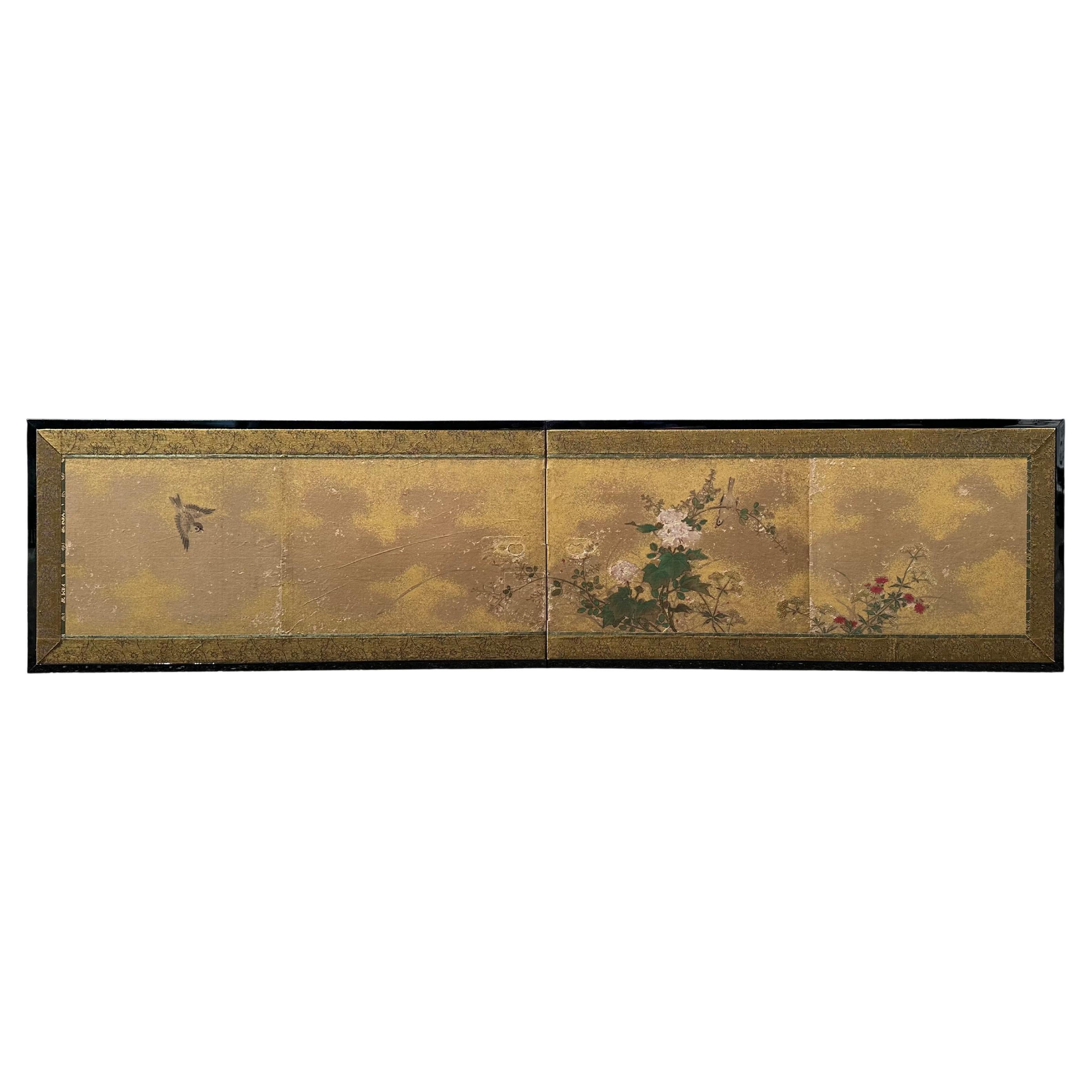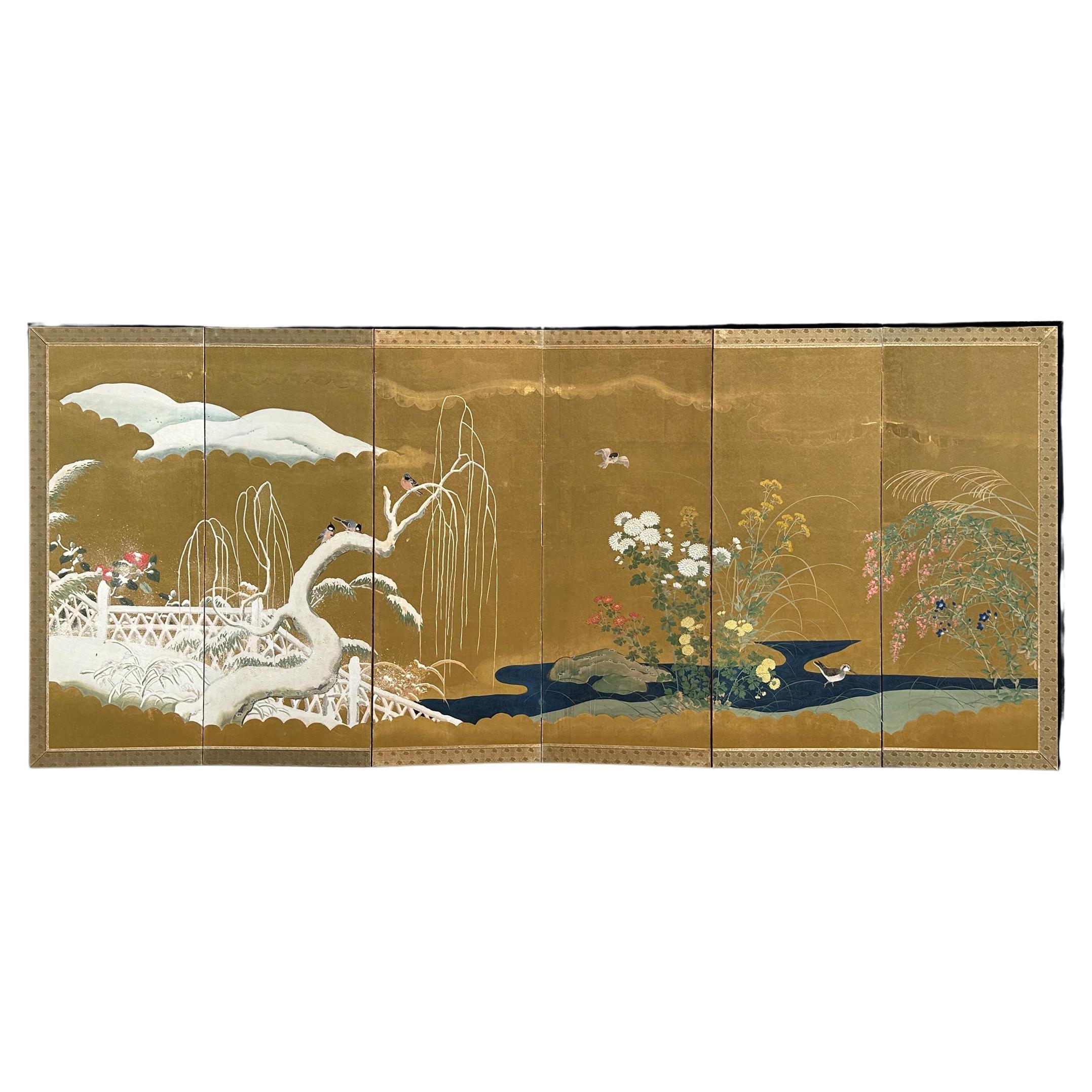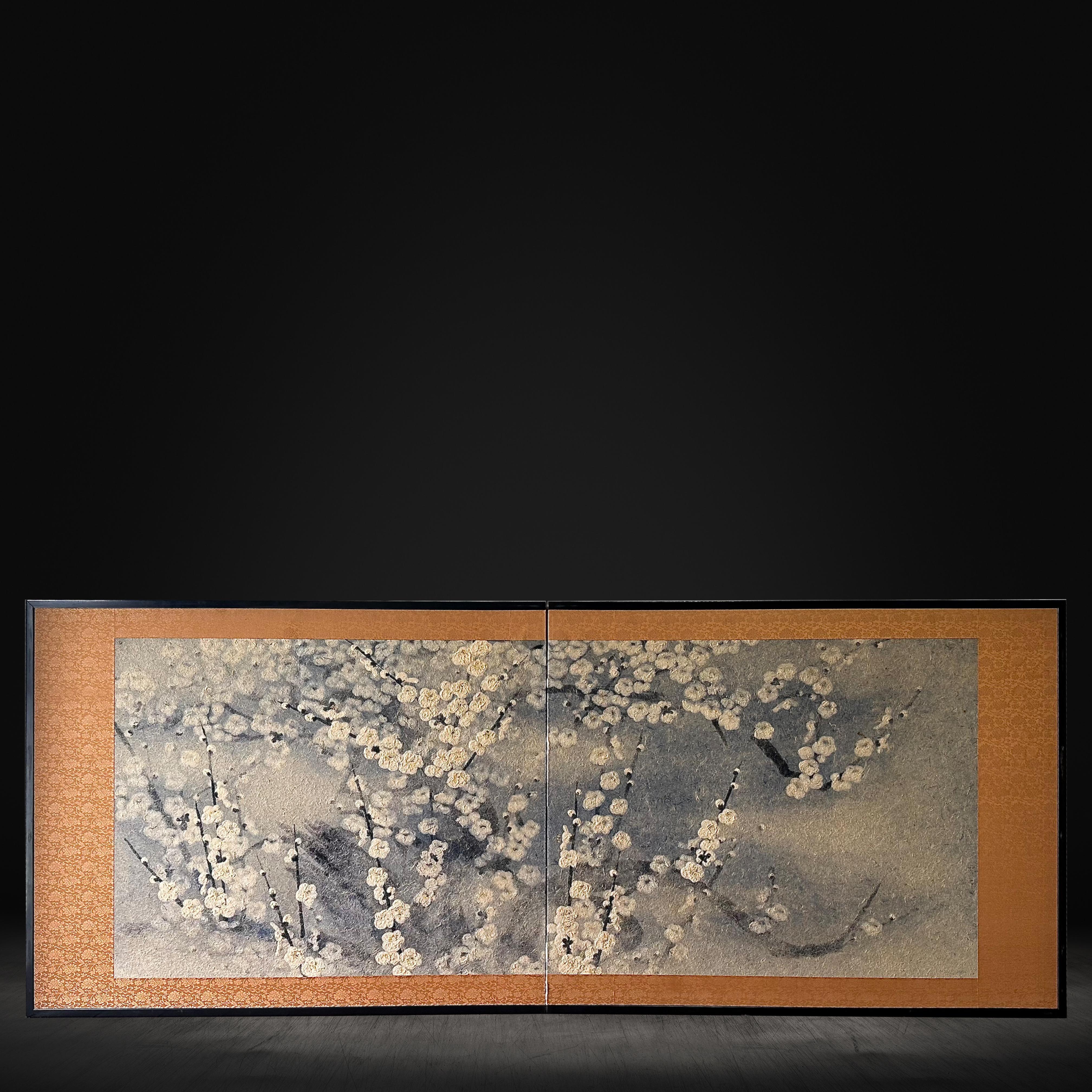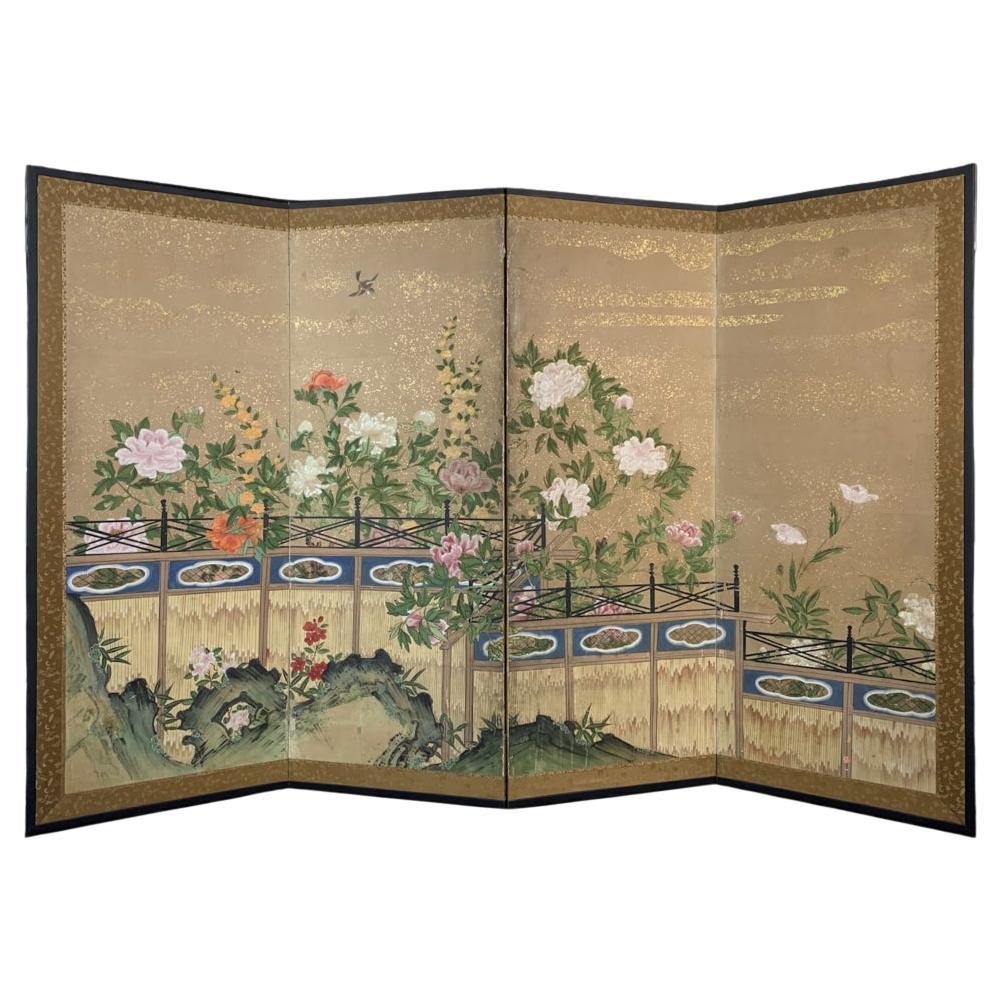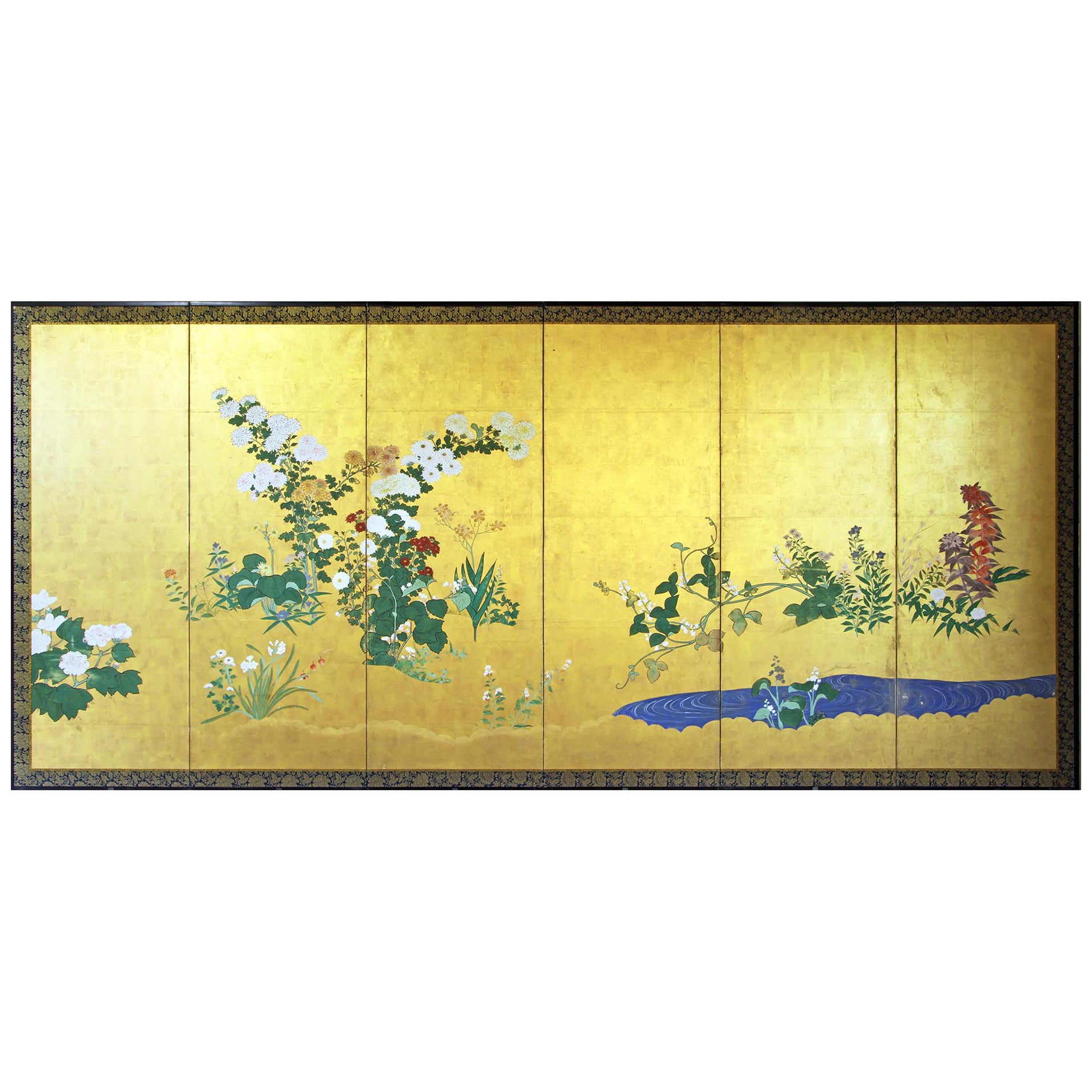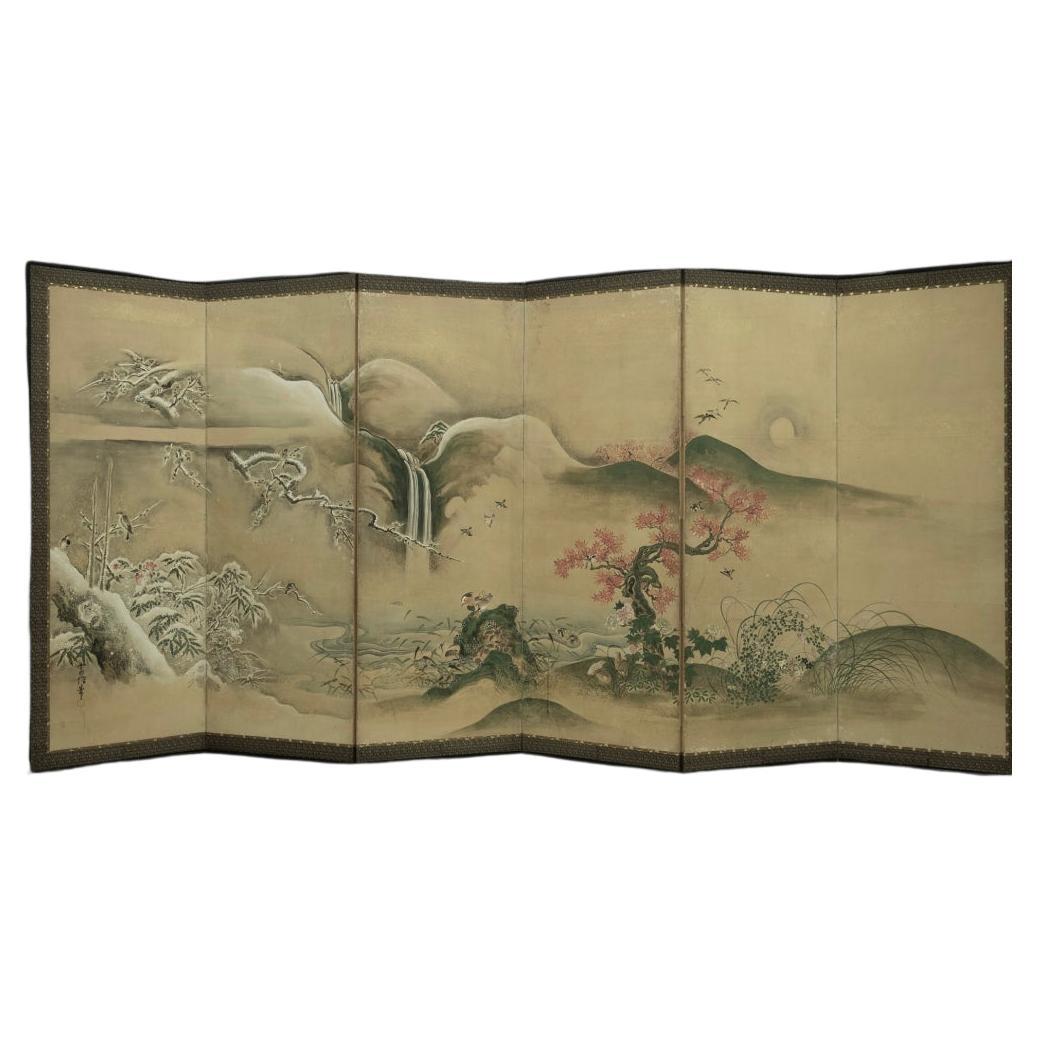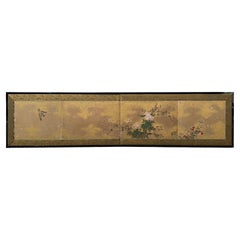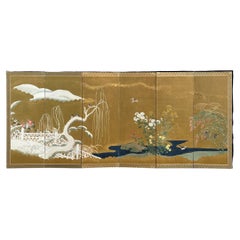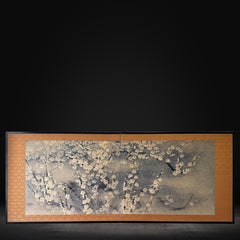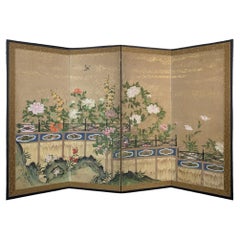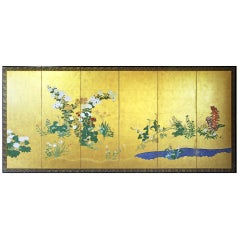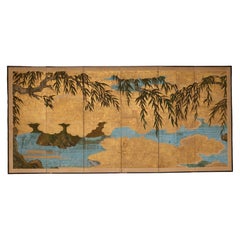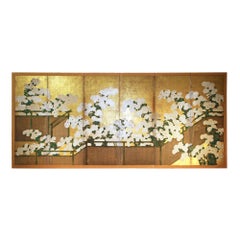Items Similar to Japanese screen: Melody of Magnolia Blossoms
Want more images or videos?
Request additional images or videos from the seller
1 of 16
Japanese screen: Melody of Magnolia Blossoms
$6,630
£5,140.71
€5,833.09
CA$9,503.82
A$10,334.05
CHF 5,445.04
MX$125,528.73
NOK 68,455.09
SEK 64,171.12
DKK 43,772.28
About the Item
Bathed in radiant gold, Melody of Magnolia Blossoms captures the fleeting harmony of nature in bloom. A graceful magnolia branch arcs across the shimmering surface, its petals unfolding in soft light, while small birds hover and rest among the blossoms. The artist’s masterful use of layered pigment and shadow creates a subtle three-dimensional depth — the illusion of air, movement, and silence intertwined.
This six-panel screen embodies the lyrical sensitivity of early Edo art, where every brushstroke breathes serenity and transience. It is a vision of spring distilled into gold — delicate, contemplative, and eternally alive in stillness.
- Dimensions:Height: 60.24 in (153 cm)Width: 144.89 in (368 cm)Depth: 1.19 in (3 cm)
- Style:Edo (Of the Period)
- Materials and Techniques:
- Place of Origin:
- Period:Early 17th Century
- Date of Manufacture:1700s
- Condition:
- Seller Location:Fukuoka, JP
- Reference Number:1stDibs: LU8121247270752
About the Seller
5.0
Gold Seller
Premium sellers maintaining a 4.3+ rating and 24-hour response times
Established in 1998
1stDibs seller since 2023
61 sales on 1stDibs
- ShippingRetrieving quote...Shipping from: Fukuoka, Japan
- Return Policy
Authenticity Guarantee
In the unlikely event there’s an issue with an item’s authenticity, contact us within 1 year for a full refund. DetailsMoney-Back Guarantee
If your item is not as described, is damaged in transit, or does not arrive, contact us within 7 days for a full refund. Details24-Hour Cancellation
You have a 24-hour grace period in which to reconsider your purchase, with no questions asked.Vetted Professional Sellers
Our world-class sellers must adhere to strict standards for service and quality, maintaining the integrity of our listings.Price-Match Guarantee
If you find that a seller listed the same item for a lower price elsewhere, we’ll match it.Trusted Global Delivery
Our best-in-class carrier network provides specialized shipping options worldwide, including custom delivery.More From This Seller
View AllJapanese Screen: Spring Offering
Located in Fukuoka, JP
Spring Offering is a small yet exquisitely refined Edo-period screen originally created as a backdrop for a Girls’ Day altar. Against a softly shimmering gold-leaf background, delica...
Category
Antique 18th Century Japanese Edo Paintings and Screens
Materials
Wood, Paper
Japanese Screen: Flow of Time in Gold
Located in Fukuoka, JP
Seasons Flowing in Gold is a masterful expression of depth and rhythm, painted with a subtle three-dimensional effect that brings the landscape to life. From the snow-laden willow a...
Category
Antique Early 19th Century Japanese Edo Paintings and Screens
Materials
Wood, Paper
Japanese screen: Whispers of Plum Blossoms
Located in Fukuoka, JP
In Japanese tradition, the plum tree is the first to bloom in late winter, its fragile white flowers defying the cold. It symbolizes perseverance, renewal, and the quiet strength to...
Category
20th Century Japanese Showa Paintings and Screens
Materials
Wood, Paper
Peony Blossoms Screen
Located in Fukuoka, JP
Peony Blossoms Screen
Period: Edo period 18-19th century
Size: 212 x 138 cm (83.5 x 54.3 inches)
SKU: PJ105
Experience a rare gem from Japan's heritage – an Edo period peony blosso...
Category
Antique 18th Century Japanese Edo Paintings and Screens
Materials
Silk, Paper
Edo Period Nature Screen by Kanō Tsunenobu (2/2)
Located in Fukuoka, JP
Embark on a journey through the tranquil beauty of a Japanese screen from the Edo period, crafted by the illustrious Kanō Tsunenobu, a master of the Kanō school and nephew to Kanō Ta...
Category
Antique 18th Century Japanese Edo Paintings and Screens
Materials
Paper
Showa Delicate Floral Screen
Located in Fukuoka, JP
This graceful two-panel screen captures the essence of summer with its subtle depiction of slender grasses and fine lines, artfully arranged against a golden background. The screen e...
Category
20th Century Japanese Showa Paintings and Screens
Materials
Gold Leaf
You May Also Like
Edo Landscape Japanese Folding Screen
By Japanese Studio
Located in Brescia, IT
Refined work by a painter from the first half of the 19th century, from the landscape of the "Rinpa" school by a painter from the end of the 18th century, the Rinpa school.
Six panels painted in ink on gold leaf and "gofun" on vegetable paper.
The flowers are made with the "gofun" technique, natural or pigmented white oyster powder.
Rinpa is one of the major historical schools of Japanese painting. The style was consolidated by the brothers Ogata Korin (1658–1716) and Ogata Kenzan (1663–1743).
This folding screen has a very clean design that leaves plenty of room for the beautiful golden landscape.
It comes flat and you can easily hang it with our hooks.
Lucio Morini...
Category
Antique 18th Century Japanese Edo Paintings and Screens
Materials
Gold Leaf
Japanese antique screen - EDO period - Willow over a stream
Located in Prahran, Victoria
Antique Japanese 6 panel screen from the early Edo period (C1650). One of a pair (both available). This magnificent golden screen shows...
Category
Antique 1650s Japanese Edo Paintings and Screens
Materials
Gold Leaf
Japanese Six-Panel Screen, a Garden for All Seasons
Located in Hudson, NY
An imaginary garden with flowers from all seasons including spring lilies, summer hibiscuses, autumn chrysanthemums, and winter berries. Wild autumn grasses move in a soft breeze wit...
Category
Antique 1890s Japanese Meiji Paintings and Screens
Materials
Gold Leaf
Japanese Screen mid Edo gold leaf
By Japanese Studio
Located in Brescia, IT
This 18th century six-panel screen is truly special. The author is unknown, but his singular genius in portraying dozens of chrysanthemum flowers created with the white of the "gofun...
Category
Antique Mid-18th Century Japanese Edo Paintings and Screens
Materials
Gold Leaf
Japanese Six-Panel Screen
Located in Stamford, CT
A six-panel Japanese paper screen with poems, autumn flowers, bamboo fence and Mandarin ducks. Poems are believed to be earlier but were probably...
Category
Antique Mid-19th Century Japanese Edo Paintings and Screens
Materials
Paper
$19,900
Early 20th Century Japanese Cherry Blossom Screen by Kano Sanrakuki
Located in Kyoto, JP
Cherry Blossoms
Kano Sanrakuki (1898-1981)
Showa period, circa 1930
2-panel Japanese Screen
Color, gofun and gold leaf on paper
Against a backdrop of gold-leafed ground, the lichen covered trunk and branches of the life-sized cherry blossom tree reach out and beyond the confines of the pictorial surface. The overall composition has a feeling of flatness which draws emphasis to the surface and the three-dimensionality of the cherry blossoms. Painstakingly built-up layers of thickly applied shell-white gofun detail the voluminous blossoms and cover large areas of this tour-de-force of Japanese Nihonga painting. By simplifying the background, minimizing the number of colors and depicting the blossoms with such heavy relief, the artist has emphasized the stunning presence of the cherry tree. The type of tree depicted is the Yae-Zakura; a double-layered type of cherry blossom famed for its beauty and strength. When we think of Japanese cherry blossoms, the first thing that comes to mind is Somei Yoshino variety, which has a single flower with five almost white petals. This type is fragile and easily blown away by strong wind or rain. Most of the double-flowered cherry blossoms begin to bloom when the Somei-Yoshino falls, and the flowering period lasts longer than that of the Somei-Yoshino.
Kano Sanrakuki originally studied painting at the Kyoto City Arts and Crafts School under the tutelage of Yamamoto Shunkyo...
Category
Early 20th Century Japanese Showa Paintings and Screens
Materials
Gold Leaf
